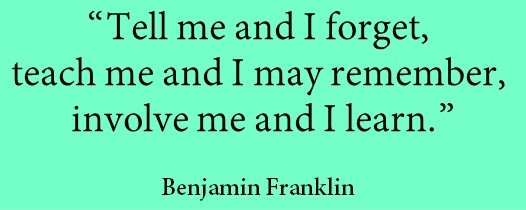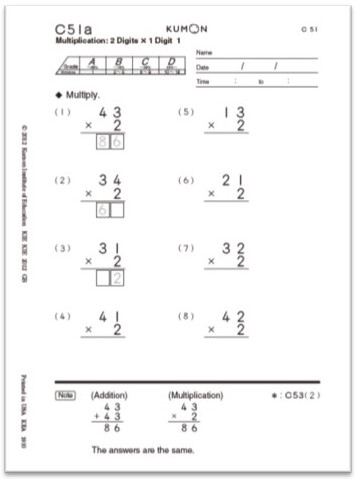For a number of children, a big part of being able to enjoy studying maths and English is learning to overcome a fear they have developed. Not only does anxiety damage their confidence in the short-term, but it can also have a lasting effect on them as they mature.
In order to develop confidence early in their Kumon journey, we make sure that we set work that is manageable because it’s important that the child enjoys the learning process and gets to experience enjoyment in their own success. No matter how advanced or lacking in confidence a child is when they come to Kumon, it’s important for them to feel supported in trying out their knowledge. Learning how to use the worksheets as a guide to learn from is a big part of developing that confidence.
At the start of their Kumon journey
When your child initially started studying with Kumon, the Instructor spent time with them as they completed the diagnostic test, and then after analysing their observations and findings, discussed a study plan with you. As well as setting work that is at the ‘just right’ level for them, initially the Instructor was looking to develop your child’s study skills such as working with pace, focus and concentration. The Instructor showed the child how to use the guidance in the worksheets to work out the solutions rather than expecting to be ‘taught’ in the traditional manner. Commonly, a child is not used to working in this way and they are quick to raise their hands in class when they get ‘stuck’ or, perhaps they seek a lot of reassurance from the Instructor. That’s why this new experience is so valuable to them in their journey to become an independent learner.
How can Kumon worksheets actually teach the child?
We want children to gain the ability and confidence to be able to think for themselves and to form and try out hypotheses based on their existing knowledge. They learn to make judgements based on their own logic, and we believe every child, regardless of age or school year, is able to do this with practice. Additionally, we are looking to develop children’s other abilities such as curiosity, noticing hints and clues, and showing them that if they pause and think deeply, they can work out the answers themselves. Learning in this way is powerful, memorable and more rewarding than simply being taught a process of doing something.

When introducing worksheets that have new concepts, the Instructor may assign these so that your child works on them in class, to ensure that your child is supported and can be guided. The worksheets show example answers, clues and hints to help students work out the correct process independently. They can then apply this learning to other similar questions in the worksheets that they do afterwards at home.
Working it out for themselves
A key principle of learning with Kumon is for the child to discover new concepts for him or herself, so in the Kumon Maths Programme, the worksheets introduce the concept sum-by-sum and page-by-page, gradually allowing them to reason out the answers for themselves.
For example, the earlier part of Level C is multiplication of single-digit numbers, e.g.; 3×3=9, 4×4=16. Students repeatedly practise their single-digit multiplications so that they become confident and can complete pages of worksheets very quickly and fluently. They come to a point where they know their times tables so well, they do it without having to think consciously, they just ‘know it’. They can rely on this knowledge as they move forward in their learning.
When they reach Level C 51a, where the concept of two-digit × one-digit multiplication is introduced for the very first time, how will they feel about tackling this?

The first example on the page is 43×2= and has the box 86 already completed. Because of their fluency with single-digit multiplication, the child may look and understand that the right-hand column shows 3×2=6 and reason that this must be correct. But what about the answer box showing 8? Where did this 8 come from? A child that is already familiar with single-digit multiplication will see the pattern between an eight, a four and a two, and can accept the answer as 86 and start to work out why it is correct. Because of their experience in completing Kumon worksheets and looking at everything on the page, they will also find the note at the bottom of the page, which shows that there are two solutions for 43×2=86, achieved either through addition or through multiplication.

The worksheet then shows another example, 34×2= 6, this time with only partial completion of the left-hand box and by thinking about it, they work out that they will need to complete the second box. They may find this straight-forward as it’s single-digit multiplication which they are already confident in.
Powerful learning
The worksheets continue in this manner, giving enough practice in each concept to gently support the student. Within a few pages, the example leads the student to hypothesise what happens when there are numbers greater than nine and whether carries are also used in multiplication as well, as they already know from having learned double-digit addition. Once they work this out, they’re away and doing it for themselves!
This thrill can be very motivational and as there is an emotional response it means it is likely to be more memorable. They also feel reassured that they worked it out before and they can do it again.
The Instructor and the worksheets
The worksheets are carefully constructed so there is only one conclusion that can be reached. It is very hard for the student to misunderstand where the example answers came from, and in this way, they can hypothesise about the reasons and can be creative with their knowledge.
The Kumon Instructor’s careful observation of your child and their expertise in the setting of the ‘just right’ level of worksheet then ensures that they have enough practice to be able to complete the calculations in their head with speed. They work with each child to build upon their knowledge and help them feel fluent in the topic. The Kumon worksheet-based study programmes have developed and evolved over the course of 60 years from working with students of all abilities, and the Instructor uses them to develop all aspects of the child’s study skills.
The real expertise of the Instructor comes from enabling a student to work something out for him or herself so that overcoming the challenge becomes a thrill and therefore a deeper learning moment too.
